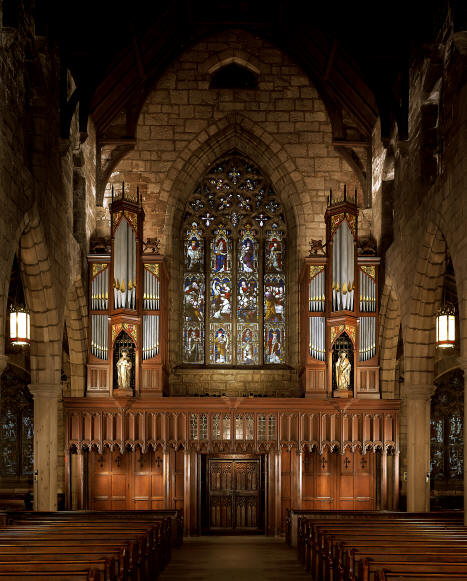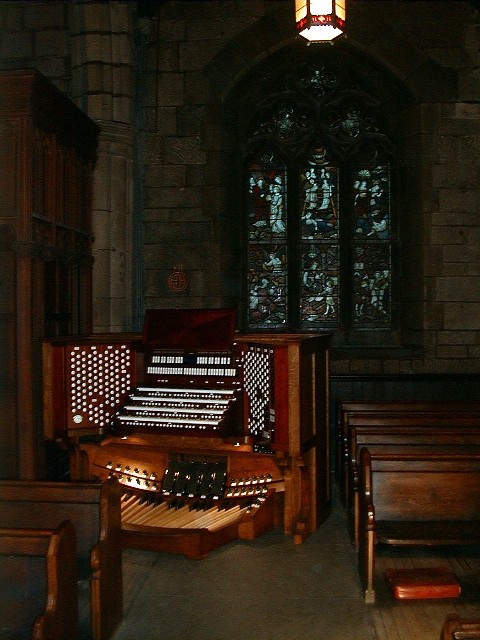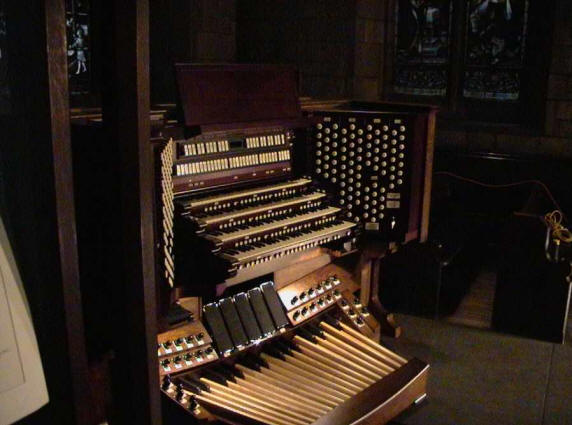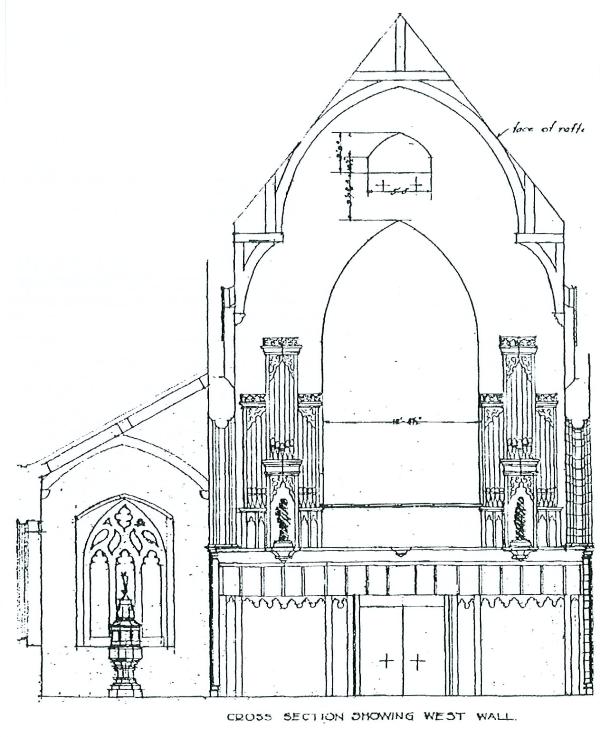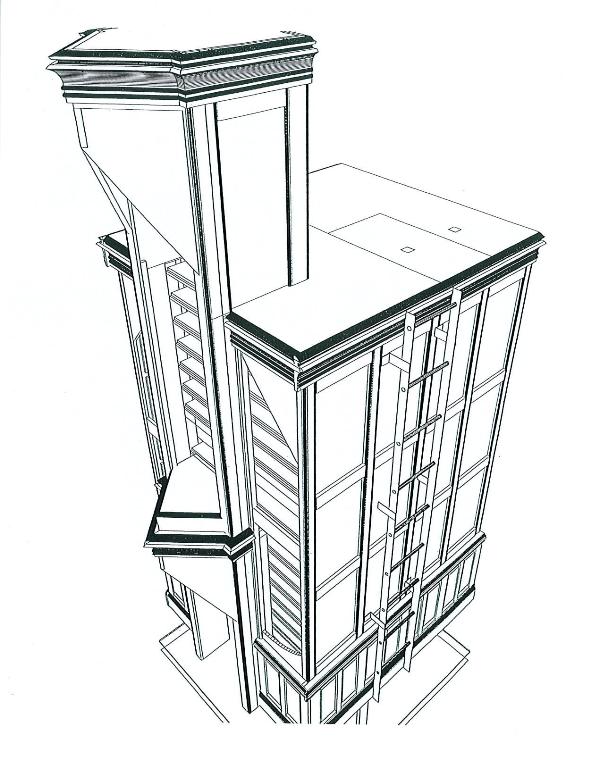Project Description
About this Project
The following article appeared in The Diapason (January 2003)
Our account of the preservation of a classic American organ all began in October of 1999 in downtown Philadelphia at Saint Mark’s Episcopal Church, a church that was officially founded in 1847. Douglas Tester, organ consultant had invited me to visit and consider our company’s participation in the work to be done on their 1937 Aeolian-Skinner organ. From the onset, there was a special energy in our discussion and the more we talked, the more stirring the vision of the project became. The challenge was to carefully undertake a work to augment an instrument of broad reputation, that is historically important, and that has served as a centerpiece in the mission of Saint Mark’s for sixty-three years. No question that the project was on hallowed ground and it was clear from the beginning that preservation of the organ was as crucial to Saint Mark’s as augmentation. Our company accepted the challenge and Saint Mark’s invitation to serve as a catalyst for the project, and in doing so became a member of a wide spread team of truly gifted and dedicated individuals.
The overall work plan covered five principal sub areas: 1) Build a new console to replace the 1965 Austin console, 2) Restore the original Henry Vaughn casework design of 1905, 3) Restore the Choir division to it’s original 1937 specifications, 4) to put into service five ranks of E.M. Skinner pipes purchased and stored by the church since 1992, and 5) add a Grand Choeur division in the west end of the church. Fortunately the stewards of Saint Mark’s had been vigilant over the years in maintaining the instrument to the highest degree. So with a composite work plan, and a well-paved way, work on the project officially began in January of 2000.
Douglas Tester, along with Ray Moderski, and Walter Peterson, both parishioners of St. Mark’s, created original specifications for additions to the organ. In the meantime, in August of 2000, Scott Dettra arrived as the new organist of St. Mark’s and Daniel Angerstein of Daniel Angerstein Organ Works in Hendersonville, NC was commissioned to be the tonal director for the project. The combined experience of all involved was extraordinary as can be heard in the distinctive tonal qualities of the new organ. Together, they continued to further refine the specification and tonal qualities as Daniel reviews in the next few paragraphs:
It has been said that G. Donald Harrison tonal finished the Aeolian-Skinner Organ in 1937 from a seat in the Chancel with, presumably a person at the loft console and a pipe assistant in the chamber. The rationale for this was that the congregation was not as involved with the music as we are today; and that the balance for the choir of men and boys was more important. Be that as it may, the organ of some 104 ranks was stuffed into the side and attic of the chancel, and was quite in the way of itself. For example, the Choir 16’ Viola is borrowed to the Pedal. This borrow is actually an independent rank, further inhibiting the organ’s egress. We believe that this is true of the independent 8’ Viola as well.
In 1963, in an attempt to gain more dynamic level from the organ to the room, the center tower of the façade was torn out, along with a part of the casework. This was part of a plan to “flowerbox” the Great division. This dental declamatory had been allowed to remain for some 40 years, while the flowerbox version never appeared.
In the year 2000 a movement appeared which said, “We want an organ which will fill our room!” The left over casework of the 1930 Midmer-Losh organ in the rear of the room appeared to be the answer. The Grand Choeur idea evolved into an instrument of such proportions and sonorities to be capable of pulling the sound from the front instrument while not obliterating it.
A most forward-looking gentleman, Mr. Wesley Parrott, procured some E. M Skinner stops from organs in the area: 8’ Flauto Mirabilis, 8’ Flugel Horn, 8’ Cornopean, 16’ and 8’ English Horn and 8’ French Horn. He purchased these many years ago and preserved them in the basement of St. Mark’s Church. We lovingly took these and incorporated them into the specification, along with other new pipe work.
The 16’ & 8’ English Horn, and the 8’ Tuba, were added to become the new Solo Organ; the pipes placed in the String division. This division has room to house these pipes without getting in the way of the rest of the organ. The Tuba is on 18” of wind, and the English Horn on 10”, its original wind pressure. The English Horn had been placed in the Choir on the original 4’ Zauberflote toeboard. We made a copy of the 4’ Zauberflote located at the Church of the Advent, Boston; an Aeolian-Skinner built only a year earlier in 1936.
The new Tuba and Trompette en chamade are from A. R. Schopp’s Sons, Inc., and are quite glorious. The en chamade is placed under the west window, at a 15-degree angle.
The purpose of an antiphonal organ is not only for antiphonal effects; it is also to draw out sound from the front organ. In order to accomplish this effectively, one must duplicate many sonorities that are produced by the front instrument. This is why we included sounds from strings to choruses, flute colors, to a 32’ Bombarde. It has been remarkably successful.
In designing the console, our company deliberately considered the combined works of Aeolian-Skinner with much attention being paid to the use of materials and to the details of finishing work. Because of their elevated degree of quality and concentration of detail in recreating the Skinner tradition, Harris Precision Products was selected to provide all of the mechanical components for the console. Walker Technical Company provided the combination action and solid state switching system. While the addition of Walker components represent the only real deviation from the original instrument, it greatly enhances its reliability, consistency and utility.
The design for the Grand Choeur casework was the inspiration of Davis D’Ambly, a parishioner of St. Mark’s Church and a liturgical artist by trade. With profound respect and appreciation for the ecclesiastical Gothic surroundings in which the organ was to be placed, Davis agreed to design and oversee the materials and finishes of the organ. He spent many hours in session in the rear stall of the choir studying Vaughn’s brilliant casework in the front of the church. Amazingly, remaining pieces of the Henry Vaughn casework were found in the basement of the church. Mr. Richard W. Langnor of Philadelphia recreated the original case in astonishing detail. The ultimate effect of Davis’s artistic labor is a complement to the existing artistry and craftsmanship found throughout the church. St. Mark’s Church now has exceptional examples of octagonal Gothic towers in the screen organ, rounded Gothic towers in the main organ case and triangular Gothic towers in the Grand Choeur casework. All are unique in their own way but tied together beautifully within the church.
For many years, alabaster statues of Sts. Peter and Paul had stood alone under the window in the west end of the nave of the church. Louise Pezzi, a gifted blacksmith in Philadelphia, was commissioned to design and execute the elegant grillwork that now serves as a milieu to the statues within the Grand Chouer casework.
The design also called for several hand carved wooden elements. We were privileged to work with David Caldwell of Caldwell Carvings in Lawndale, NC. The extensive and exquisite carving work done on the organ from the pipe shades to the linen folds and the lions to the cresting are a testament to the complete dedication David has to his vocation. He and Davis also worked together on the polychroming and gilding of all the carvings.
John Dower of Regalia, Inc. in Lincolnton, NC was delegated the responsibility of developing working engineering drawings for the exterior and interior of the organ. Laying out the new pipe work within the extreme space limitations was a challenge that John succeeded in accomplishing quite well. His firm then developed the layouts for and constructed the wind chests to be included in the organ.
In building the console and casework, our master woodworker, George Zong and Eric Molenaar worked in conjunction with Davis in selecting each piece of quarter sawn white oak timber to be used in the organ. A majority of the wood utilized on this project was harvested from the same stand of trees that were located less than an hour from the church. The continued focus of our work was on preserving the artistic detail and quality of craftsmanship found throughout St. Mark’s. Thomas Linder, our pipe maker, and his apprentice, Brent Johnson, painstakingly worked to reinstate the missing pipes from the main organ case. By studying old photographs and measuring surviving pipes, they were able to precisely match the originals. Marty Lemons did delicate finishing work on the console and Grand Chouer casework. Jim Twyne, the tonal director of Cornel Zimmer Organ Builders, worked in close association with Daniel in preparing all of the pipes in our factory before shipment to the church. Judy Abernathy and Doug Jones of our electrical department completed wiring and testing of the entire instrument. Installing and rewiring the organ on site was performed by most everyone noted in this article and many more. A very particular thanks should go to the many technicians at Walker Technical Company and to all the volunteers of St. Mark’s Church.
The dedication service held on April 26, 2002, with an immensely talented Scott Dettra at the console, marked the completion of this exceptional project. It was a milestone day, unforgettable to me as I listened to new planes of music being performed on the classic organ, rich with the old and new voices, beautifully vibrant and roused again. All of the team’s talents and dedication on this project came together beautifully. A revered organ had been made hardy for a new day with all of its historic qualities intact, ready, if you will, to become even more historic.
On behalf of all involved in this project, I would like to observe that each and every member of the project accomplished something unique and memorable, and that the organ of Saint Mark’s is going to reflect our good works for many years to come. At Cornel Zimmer Organ Builders, we will always be proud to have been chosen to participate in this work, and we express our most sincere appreciation to Father Richard Alton and to all of the parishioners of St. Mark’s Church. It was an extraordinary experience, totally in keeping with mission of our company which is to work together efficiently and productively to create exquisite organs of the highest quality, durability and dependability resulting in highly satisfied clients and works of musical art that will contribute to the glory of God for many generations to come.
Authors: Cornel Zimmer with contribution from Daniel Angerstein
Stop List
|
||||||||||||||||||||||||||||||||||||||||||||||||||||||||||||||||||||||||||||||||
|
||||||||||||||||||||||||||||||||||||||||||||||||||||||||||||||||||||||||||||||||
|
||||||||||||||||||||||||||||||||||||||||||||||||||||||||||||||||||||||||||||||||
|
||||||||||||||||||||||||||||||||||||||||||||||||||||||||||||||||||||||||||||||||
|
||||||||||||||||||||||||||||||||||||||||||||||||||||||||||||||||||||||||||||||||
|
||||||||||||||||||||||||||||||||||||||||||||||||||||||||||||||||||||||||||||||||
|
||||||||||||||||||||||||||||||||||||||||||||||||||||||||||||||||||||||||||||||||
|
||||||||||||||||||||||||||||||||||||||||||||||||||||||||||||||||||||||||||||||||
|
||||||||||||||||||||||||||||||||||||||||||||||||||||||||||||||||||||||||||||||||
|
||||||||||||||||||||||||||||||||||||||||||||||||||||||||||||||||||||||||||||||||
|
||||||||||||||||||||||||||||||||||||||||||||||||||||||||||||||||||||||||||||||||
|
||||||||||||||||||||||||||||||||||||||||||||||||||||||||||||||||||||||||||||||||


